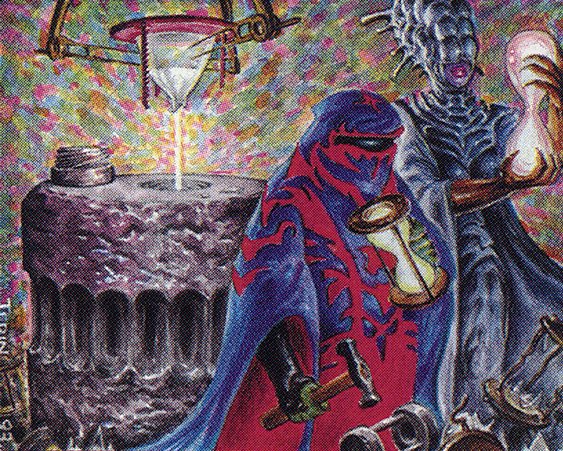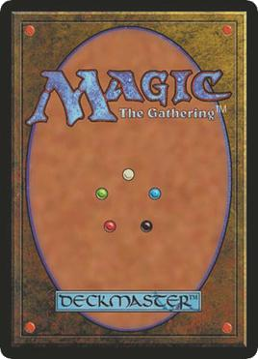 Art by Mark Tedin
Art by Mark TedinCloned from Clone of High Stakes Challenge (HSC) Vintage Cube
Cloned from High Stakes Challenge (HSC) Vintage Cube
A fun and power-maxxed 336 card vintage cube designed for enjoying and exploiting the most potent cards from throughout MTG's history. Optimized to maintain balance while preserving the significant Vintage Cube archetypes, while excluding archetype-blanking hate cards. Designed for 8 player draft pods with three 14 card packs/player, yielding 42 card draft pools.
For an explanation of why the cube was slimmed down from 360 cards to 336 cards, check out this blog post: http://cubecobra.com/cube/blog/blogpost/d597a939-a2c5-41e7-9e20-8ee7109cf083
As you can see from the blog, we make frequent changes to the cube to maximize the gameplay experience while adhering to the following four core cube tenants:
1) Power LevelAs a lean vintage cube with the Power 9 and heaps of ultra-fast artifact mana, the HSC cube seeks to intensify cube speed and power level. Along these lines, we try to incorporate as many busted vintage-level combos as possible, as long as they’re also fun and (at least sometimes) interactive. As you’ll see in the archetype descriptions below, the HSC cube has maximized threat density, while cutting the chaff from vintage cube. 2) Balance
All of the major vintage cube archetypes described below should be well supported & competitive, without there being too many duplicative effects. Many of our changes are designed to preserve HSC cube balance as much as power level. Whenever one archetype starts to dominate, we take steps to re-balance, ideally by strengthening the remaining archetypes, rather than weakening the dominant one. 3) Diversity & Replayability
Perhaps the biggest strength of vintage cube is that firing up new drafts truly never gets boring. The HSC cube seeks to amplify this strength with solid fixing and multicolor support, so that drafters who pursue unique & less streamlined approaches are rewarded for their efforts. That said, mono color aggro & ramp decks are very strong, as are dedicated combo builds. 4) Fun
While fun is a subjective quality, most agree that there is a direct correlation between interactivity and fun in MTG gameplay. In vintage cube, there will always be a certain number of un-interactive blowouts — think turn 1 Lotus/Lurrus loops, turn 1-2 Channel/Emrakul, turn 1/2 Strip Mine locks, etc. These are unavoidable, and are baked into the format. However, design choices can also be made to enhance interactivity, and thus fun. The HSC cube seeks to incorporate cards with fun & interactive effects, and exclude boring, unanswerable cards (such as Manifold Key, Progenitus, True-Name Nemesis, etc.) or archetype-blanking hate cards.
1) Speed
The HSC cube is much faster than MTGO’s vintage cube. It has all the same explosive artifact mana from MTG’s early days, but with 336 cards vs. 540 for MTGO, there’s a much higher density of power in each draft. 58 cards in the HSC cube are not found in MTGO’s vintage cube (highlighted in purple on the cube list), including some very high end threats like Time Vault, White Plume Adventurer, and Comet Stellar Pup.
2) Abundant FixingTo help multicolor archetypes hold their own against nimble aggro & combo decks, we doubled the number of fetch lands in every color pairing except Selesnya & Orzhov (which are largely unsupported). There are 18 fetch lands (plus Prismatic Vista, so really 19) in the HSC cube complementing 10 dual lands and 8 shock lands, and all lands that etb tapped have been cut. Green supports many additional multicolor fixers like Lotus Cobra, Dryad of the Ilysian Grove, Utopia Sprawl, and 5 multicolor mana producing dorks, etc. to further enable 4-5c decks. And there are plenty of powerful payoffs to reward drafters for diversifying their mana base. In total, 17.3% (58/336) of the cube is devoted to multicolor fixing through lands, mana rocks, and green spells (excluding lands/rocks/dorks that only generate colorless or mana of a single color).
3) Cut Fringe Archetypes & CardsSome hard choices were made to trim the cube down to 336 cards. In doing so, some weaker/slower cards that generally underperform or can get blown out like Oath of Druids, Eureka, the equipment swords, Stax cards, etc. were cut. Plenty of powerful cards were cut as well. However, as you’ll see below, 95%+ of the classic vintage cube archetypes were preserved (and a couple new ones unlocked).
4) Cut Hate Cards/Color HosersWe believe the MTGO vintage cube has far too many graveyard & archetype-blanking hate cards, and cut almost all of them in HSC. So, no more Relic of Progenitus, Containment Priest, Lion Sash, Soul-Guide Lantern, Red Elemental Blast, Scavenging Ooze, Endurance, etc. Interacting with GYs is one of the most iconic & fun things to do in vintage cube, and so we eliminated cards which prevent this, giving a boost to Reanimator, Storm, Time Walk Recursion, Land Destruction, Emry/Lurrus decks, etc. However, a few broader hate cards remain, like Noxious Revival, Dauthi Voidwalker, Thalia/Esper Sentinel, Fiery Confluence, Sheoldred/Orcish Bowmasters, and some (primarily black) sweepers to rein in aggro.
5) Plenty of Planeswalkers, Legends, & Better RemovalThe HSC cube has 57 Legendary cards (17%), including 20 Planeswalkers (only 2 of which have a mana value greater than 4). Removal in the HSC cube is also faster and more impactful. We cut most of the sorcery and enchantment based removal in favor of flexible, instant speed removal spells that hit a broader range of targets than creatures alone.
1) Aggro/Aggressive Midrange
The mono red and WW decks set the pace for the cube, and you should always have a plan in mind for dealing with their hyper-efficient threats. While in the past these builds sacrificed resiliency for speed, they now have more staying power with indestructibility, protection, and blink in white, and a heavy concentration of 4-5mv finishers in red (aggro midrange). These decks enjoy a host of instant speed, flexible removal options which let them dominate the battlefield. Boros (
 ) Aggro is also much stronger in the HSC cube than in MTGO’s vintage cube. Don’t sleep on Comet, Forth Eorlingas, and Otharri — they hit hard! The combination of initiative creatures, the best removal spells, and extremely powerful red creatures like Ragavan, Inti, and Laelia keep these aggro decks in the top tier of competitive play.
) Aggro is also much stronger in the HSC cube than in MTGO’s vintage cube. Don’t sleep on Comet, Forth Eorlingas, and Otharri — they hit hard! The combination of initiative creatures, the best removal spells, and extremely powerful red creatures like Ragavan, Inti, and Laelia keep these aggro decks in the top tier of competitive play.
One of the most significant additions which distinguishes the HSC cube from MTGO’s vintage cube is the Time Vault package. The main Time Vault enablers are Kiora Behemoth Beckoner (
 ), Saheeli Sublime Artificer (
), Saheeli Sublime Artificer (
 ), Sonic Screwdriver, and Enlightened Tutor, as well as Pestermite, Deceiver Exarch, and Turnabout, which each provide an extra turn by untapping your TV (and more with Ephemerate). Most of these enablers (not Saheeli) also combo explosively with The One Ring. Kiora is the fastest & most desirable combo piece, and she'll also see play in several other cube archetypes. Sonic Screwdriver can be turbo'd out with Mishra's Workshop, and is an appropriately costed key effect. We decided against including Manifold/Voltaic Key in the cube because at 1mv those cards are simply too fast & uninteractive - at least with 3mv enablers the opponent has an opportunity to respond and break up the combo.
), Sonic Screwdriver, and Enlightened Tutor, as well as Pestermite, Deceiver Exarch, and Turnabout, which each provide an extra turn by untapping your TV (and more with Ephemerate). Most of these enablers (not Saheeli) also combo explosively with The One Ring. Kiora is the fastest & most desirable combo piece, and she'll also see play in several other cube archetypes. Sonic Screwdriver can be turbo'd out with Mishra's Workshop, and is an appropriately costed key effect. We decided against including Manifold/Voltaic Key in the cube because at 1mv those cards are simply too fast & uninteractive - at least with 3mv enablers the opponent has an opportunity to respond and break up the combo.
Storm is considerably stronger in the HSC cube than in MTGO’s vintage cube, because of the much higher density of both fast artifact mana and cheap spells. The HSC cube consists of 31% (104/336) cheap (1-2 mana) non-creature, non-land spells — a significantly higher ratio than in MTGO’s vintage cube. Therefore, storm drafters have an ample pool of firepower from which they can seed their decks. Typically Grixis (

 ), Storm decks utilize classic finishers like Brain Freeze & Tendrils and key enablers like Underworld Breach, YawgWill, LED, etc. Just watch out for Lose Focus (a counterspell that can give storm decks some headaches) and instant speed enchantment removal on your Breach.
), Storm decks utilize classic finishers like Brain Freeze & Tendrils and key enablers like Underworld Breach, YawgWill, LED, etc. Just watch out for Lose Focus (a counterspell that can give storm decks some headaches) and instant speed enchantment removal on your Breach.
Usually Gruul (
 ) based, the lands archetype is very well supported in this cube, benefitting especially from the addition of extra fetch lands, which guarantee consistency for the archetype's signature GY recursion combo. The three enablers for this combo are Wrenn & Six, Crucible of Worlds, and Life from the Loam. Crop Rotation and Once Upon a Time (and sometimes Gamble as well) serve as land tutors for Strip Mine/Wasteland. Cards like Fastbond, Lotus Cobra, Courser of Kruphix, Dryad of Ilysian Grove, and Tireless Tracker all help supplement this archetype’s strategy, and Minsc & Boo is always a welcome addition if you can pick them up.
) based, the lands archetype is very well supported in this cube, benefitting especially from the addition of extra fetch lands, which guarantee consistency for the archetype's signature GY recursion combo. The three enablers for this combo are Wrenn & Six, Crucible of Worlds, and Life from the Loam. Crop Rotation and Once Upon a Time (and sometimes Gamble as well) serve as land tutors for Strip Mine/Wasteland. Cards like Fastbond, Lotus Cobra, Courser of Kruphix, Dryad of Ilysian Grove, and Tireless Tracker all help supplement this archetype’s strategy, and Minsc & Boo is always a welcome addition if you can pick them up.
By eliminating all GY hate cards, and increasing the density of 1 mana or free black disruption spells, Reanimator decks are also stronger & more consistent in the HSC cube than in MTGO’s vintage cube. This is true for both traditional, sorcery-speed reanimation variants utilizing Reanimate, Animate Dead, Necromancy, and Life//Death, as well as instant-speed reanimation decks that use Shallow Grave & Corpse Dance to annihilate their opponents with Eldrazi attacks. Splash blue for more options (like Flash, Frantic Search, Ledger Shredder, etc.), and some Dimir (
 ) value cards. Additionally, Unmarked Grave was added as a secondary Entomb to improve deck consistency. Archon of Cruelty & Atraxa have been impressive new reanimation targets to complement Griselbrand & Grave Titan.
) value cards. Additionally, Unmarked Grave was added as a secondary Entomb to improve deck consistency. Archon of Cruelty & Atraxa have been impressive new reanimation targets to complement Griselbrand & Grave Titan.
The HSC cube’s philosophy for strengthening the mono green ramp deck was fairly straightforward — add a second Craterhoof effect (End-Raze Forerunners), and help the deck cast those hasty tramplers even faster. To further turbo charge green ramp/cheat decks, we added Monster Manual to complement Channel & Natural Order and long standing green powerhouses Nissa Who Shakes the World & Garruk Wildspeaker. Spicy Natural Order targets like Atraxa, Gruff Triplets, and Worldspine Wurm keep things interesting. There’s also Worldly Tutor to fetch up your favorite beast, boar, giant, wurm, satyr warrior, or corrupted angel. We cut most of the 4-5 mana midrangy green creatures (but not Questing Beast or Undermountain Adventurer) in order to streamline the archetype’s focus. Pest Infestation is a powerful & scalable threat, and Court of Garenbrig introduces The Monarch to Green decks. Mono Green Ramp is once again a top tier archetype.
7) Izzet TwinIzzet (
 ) is one of the strongest color combinations in vintage cube. You have access to the full range of broken blue spells & counters, flexible burn, premium artifact destruction & theft in Fiery Confluence & Dack Fayden, as well as fun combos like Splinter Twin (but no Kiki-Jiki). The other key combo pieces remain, including Splinter Twin, Zealous Conscripts, Fable of the Mirror-Breaker, Pestermite, and Deceiver Exarch. There is also a strong UR build of the Time Vault combo (utilizing Ral Zarek, Saheeli Sublime Artificer, and Kiora Behemoth Beckoner). Ledger Shredder & DRC help filter your deck, and flexible, efficient, value spells like Prismari Command & Expressive Iteration round out this high performing guild. Izzet (
) is one of the strongest color combinations in vintage cube. You have access to the full range of broken blue spells & counters, flexible burn, premium artifact destruction & theft in Fiery Confluence & Dack Fayden, as well as fun combos like Splinter Twin (but no Kiki-Jiki). The other key combo pieces remain, including Splinter Twin, Zealous Conscripts, Fable of the Mirror-Breaker, Pestermite, and Deceiver Exarch. There is also a strong UR build of the Time Vault combo (utilizing Ral Zarek, Saheeli Sublime Artificer, and Kiora Behemoth Beckoner). Ledger Shredder & DRC help filter your deck, and flexible, efficient, value spells like Prismari Command & Expressive Iteration round out this high performing guild. Izzet (
 ) and Jeskai (
) and Jeskai (

 ) spellslinger decks also have plenty of ammunition now with Third Path Iconoclast and Chrome Host Seedshark buttressing Saheeli and Monastery Mentor.
) spellslinger decks also have plenty of ammunition now with Third Path Iconoclast and Chrome Host Seedshark buttressing Saheeli and Monastery Mentor.
Simic (
 ) decks often take advantage of the fact that even in a hyper-fast, 336 card vintage cube that’s been optimized for power, slamming Oko on turn 2 will still just win the game for you 90% of the time. And when paired with either blue power like Time Walk/Ancestral, or explosive green cards like Natural Order, this deck is a consistent top performer. Simic is also one of the most flexible color pairings, and there are a variety of different directions you can build towards — Time Walk recursion, Draw 7s, Natural Order, Lands, Ramp, and 4-5c Uro/Omnath piles are all possibilities. When paired with mana dorks/rocks, Kinnan Bonder Prodigy really helps to accelerate any of those game plans (plus Kinnan combos with Basalt Monolith to generate infinite colorless mana).
) decks often take advantage of the fact that even in a hyper-fast, 336 card vintage cube that’s been optimized for power, slamming Oko on turn 2 will still just win the game for you 90% of the time. And when paired with either blue power like Time Walk/Ancestral, or explosive green cards like Natural Order, this deck is a consistent top performer. Simic is also one of the most flexible color pairings, and there are a variety of different directions you can build towards — Time Walk recursion, Draw 7s, Natural Order, Lands, Ramp, and 4-5c Uro/Omnath piles are all possibilities. When paired with mana dorks/rocks, Kinnan Bonder Prodigy really helps to accelerate any of those game plans (plus Kinnan combos with Basalt Monolith to generate infinite colorless mana).
Artifact decks are consistent top performers in the HSC cube, with many powerful & iconic Jeskai (

 ) pieces — Mishra’s Workshop, Tolarian Academy, Urza’s Saga, Balance, Stoneforge Mystic, Tinker, Upheaval, Urza Lord High Artificer, Emry Lurker of the Loch, Retrofitter Foundry, Currency Converter, Myr Battlesphere, Triplicate Titan, Sundering Titan, Karn Scion of Urza, Goblin Welder, Zirda the Dawnwaker — all present, along with heaps of fast artifact mana. Tinker out a Triplicate Titan or Myr Battleball to threaten your opponent right off the bat, or generate heaps of artifact mana before casting a devastating Upheaval. Zirda combos with both Basalt & Grim Monoliths to generate infinite colorless mana, and is also great with Retrofitter Foundry & Walking Ballista. The One Ring is a powerhouse all on its own, but becomes broken when you find extra ways to untap it (with Kiora, Pestermite, Deceiver Exarch, Turnabout, or Sonic Screwdriver).
) pieces — Mishra’s Workshop, Tolarian Academy, Urza’s Saga, Balance, Stoneforge Mystic, Tinker, Upheaval, Urza Lord High Artificer, Emry Lurker of the Loch, Retrofitter Foundry, Currency Converter, Myr Battlesphere, Triplicate Titan, Sundering Titan, Karn Scion of Urza, Goblin Welder, Zirda the Dawnwaker — all present, along with heaps of fast artifact mana. Tinker out a Triplicate Titan or Myr Battleball to threaten your opponent right off the bat, or generate heaps of artifact mana before casting a devastating Upheaval. Zirda combos with both Basalt & Grim Monoliths to generate infinite colorless mana, and is also great with Retrofitter Foundry & Walking Ballista. The One Ring is a powerhouse all on its own, but becomes broken when you find extra ways to untap it (with Kiora, Pestermite, Deceiver Exarch, Turnabout, or Sonic Screwdriver).
This combo build anchors itself by pairing some or all of the cube’s four “Draw 7” spells (Timetwister, Wheel of Fortune, Time Spiral, Echo of Eons), alongside cards which punish an opponent for (attempting to) draw cards (Hullbreacher, Narset, Sheoldred, Orcish Bowmasters, Faerie Mastermind). Supplementing this core combo should be a host of tutors, cantrips, draw effects, counterspells, and removal/disruption. Oh, and Fastbond. This archetype routinely delivers backbreaking finishes in the HSC cube.
11) Blink/FlickerThe blink deck is typically Azorius (
 ) or mono white. Ephemerate gave this archetype a huge boost, and synergizes with a whole suite of U and W creatures including Flickerwisp, Restoration Angel, Charming Prince, Thraben Inspector, Solitude, Skyclave Apparition, Loran, Palace Jailer, White Plume Adventurer, Seasoned Dungeoneer, Snapcaster Mage, Vendilion Clique, Elite Spellbinder, and Spellseeker. Using Ephemerate or a channeled Touch the Spirit Realm to blink (scam) an evoked Solitude can be devastating — delivering a one-mana double Swords to Plowshares, a free 3/2 Lifelinker, and then you get to do it again on your next upkeep (with a rebounded Ephemerate). This archetype also enjoys plenty of powerful PWs, and a healthy selection of counters, cantrips, and removal spells.
) or mono white. Ephemerate gave this archetype a huge boost, and synergizes with a whole suite of U and W creatures including Flickerwisp, Restoration Angel, Charming Prince, Thraben Inspector, Solitude, Skyclave Apparition, Loran, Palace Jailer, White Plume Adventurer, Seasoned Dungeoneer, Snapcaster Mage, Vendilion Clique, Elite Spellbinder, and Spellseeker. Using Ephemerate or a channeled Touch the Spirit Realm to blink (scam) an evoked Solitude can be devastating — delivering a one-mana double Swords to Plowshares, a free 3/2 Lifelinker, and then you get to do it again on your next upkeep (with a rebounded Ephemerate). This archetype also enjoys plenty of powerful PWs, and a healthy selection of counters, cantrips, and removal spells.
This is the second archetype in the HSC cube built around just one card (Time Walk this time), and that seeks to dominate by monopolizing all of the turns, rendering your opponent unable to play Magic. This deck is usually Simic (
 ) or Temur (
) or Temur (

 ), and aims to recur Time Walk as much as possible by retrieving or casting it from the GY. Key enablers include Snapcaster Mage, Regrowth, Jace Vryn's Prodigy, Tamiyo Collector of Tales, Noxious Revival, and Underworld Breach. This deck usually wants to string a few turns together after it has already successfully landed a PW or threatening creature, to take advantage of multiple turns of activations or attacks. A high volume of tutors (like Spellseeker, Mystical Tutor, etc.), cantrips, and counters help this deck deliver consistently.
), and aims to recur Time Walk as much as possible by retrieving or casting it from the GY. Key enablers include Snapcaster Mage, Regrowth, Jace Vryn's Prodigy, Tamiyo Collector of Tales, Noxious Revival, and Underworld Breach. This deck usually wants to string a few turns together after it has already successfully landed a PW or threatening creature, to take advantage of multiple turns of activations or attacks. A high volume of tutors (like Spellseeker, Mystical Tutor, etc.), cantrips, and counters help this deck deliver consistently.
Control decks are typically either Azorius (
 ), Dimir (
), Dimir (
 ), Grixis (
), Grixis (

 ), or heavy blue with light splashes, and perform best when they pair a few sticky & powerful threats with efficient cantrips, card draw, sweepers, and a large dose of board controlling instant speed counters & removal. They usually include either a combo finisher, a Time Walk recursion strategy, or are able to land (and protect) a threat that can take over the game. Defensive permanents like Ledger Shredder, Chrome Host Seedshark, and Aether Spellbomb can slow down aggro opponents, and efficient sweepers like Balance, Toxic Deluge, Fire Covenant, and Languish, as well as Parallax Wave, help neutralize the board. UW decks also feature several creatures with exile effects, along with many ways to blink & recur them, plus premium spot removal.
), or heavy blue with light splashes, and perform best when they pair a few sticky & powerful threats with efficient cantrips, card draw, sweepers, and a large dose of board controlling instant speed counters & removal. They usually include either a combo finisher, a Time Walk recursion strategy, or are able to land (and protect) a threat that can take over the game. Defensive permanents like Ledger Shredder, Chrome Host Seedshark, and Aether Spellbomb can slow down aggro opponents, and efficient sweepers like Balance, Toxic Deluge, Fire Covenant, and Languish, as well as Parallax Wave, help neutralize the board. UW decks also feature several creatures with exile effects, along with many ways to blink & recur them, plus premium spot removal.
The high density and power level of 3-4 mana planeswalkers in the HSC cube, along with the wide availability of good fixing has elevated the competitiveness of multicolor superfriends and good stuff decks, which dominate by saturating the board with a large volume of difficult to answer value engines. Superfriends decks are usually base green to take advantage of mana dorks for fixing and ramp, but also utilize mana rocks for this purpose. The strongest decks in this archetype can easily generate Temur (

 ) mana for casting powerhouse PWs like Oko, M&B, or Dack Fayden, while splashing black (for Ashiok, Daretti, and Grist, plus sweepers like Toxic Deluge, Fire Covenant, and Languish) or white (for T3feri, Comet, Forth Eorlingas!, and Balance) depending on the direction of the draft. Well crafted Temur (
) mana for casting powerhouse PWs like Oko, M&B, or Dack Fayden, while splashing black (for Ashiok, Daretti, and Grist, plus sweepers like Toxic Deluge, Fire Covenant, and Languish) or white (for T3feri, Comet, Forth Eorlingas!, and Balance) depending on the direction of the draft. Well crafted Temur (

 ), Sultai (
), Sultai (

 ), Grixis (
), Grixis (

 ), Jeskai (
), Jeskai (

 ), and Jund (
), and Jund (

 ) decks tend to perform quite well in the HSC cube.
) decks tend to perform quite well in the HSC cube.
The HSC cube has added some enablers (including double fetch lands) for 4-5c Omnath piles, because they’re just so much fun when they come together. In addition to a high density of mana dorks & multicolor fixing, Lotus Cobra (which can really pop off with fetch lands), Dryad of Ilysian Grove, and Exploration help this deck deliver its bigger threats well ahead of schedule. While often sharing many of the key components of the lands archetype (especially Wrenn & Six, Loam, Crucible, Fastbond, and Crop Rotation), this build is distinct and very hard to stop once it gets a full head of steam going. Drafters should prioritize fetches for this deck, as it really needs 4-5+ to reach its full potential.
16) Sneak & ShowThis archetype has gotten weaker in recent iterations of MTGO’s vintage cube, and so we’ve added additional support to keep it at the highest tier of competition in the HSC cube. In addition to Sneak Attack, Show & Tell, and Through the Breach, there are now new ways to cheat creatures onto the battlefield in Monster Manual and Flash (which synergizes especially well with Worldspine Wurm, Chaos Defiler, Sundering Titan, Triplicate Titan, Gruff Triplets, and Archon of Cruelty). This deck benefits from additional tutors in Gamble & Worldly Tutor — both absent from MTGO’s vintage cube. Chaos Defiler is an explosive new Sneak/Breach target, and Seething Song plus quality multicolor fixing help to flesh out this archetype.
This list is far from exhaustive. Powerful fan favorites like Bolas’s Citadel (alongside Sensei’s Divining Top) wins games all on its own, and often gets added to Tinker decks, Reanimator decks (with Dark Ritual), or Lurrus decks (with Black Lotus).
Orzhov and Selesnya have underperformed in the HSC cube, because each guild lacks a powerful payoff (usually a 3-4 mana Planeswalker) to reward drafters in those color combinations. Because of this, we’ve slashed those guilds to the bare minimum, as a signpost for drafters to be wary.
Have fun drafting, and enjoy the cube!!

